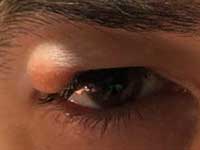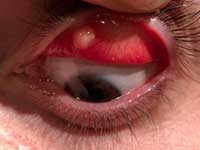What is a chalazion?
A chalazion or chalazion is a small cyst or nodule, typically between 2 and 8 mm, filled with fluid, with the appearance of a “bump or lump on the eyelid” (see photo above). It can develop on the lower eyelid or the upper eyelid, although it is more common on the upper eyelid. Chalazion can affect just one eye or both eyes.
To better identify what a chalazion is in the eye, see the images or photos above, where a lump in the upper eyelid is clearly identified. The chalazion can develop on the outer face of the eyelid (external chalazion) or on the inner face (internal chalazion) and may even grow over the free extremity (marginal chalazion).
Chalazion in the eye is a frequent disease and often disappears spontaneously (without any intervention). It is not a malignant disease and it is not contagious. Generally speaking, chalazion in the eye is not dangerous and does not affect vision, as the lump is not large enough to distort the ocular surface and cause reduced visual acuity. However, under certain circumstances vision can be affected if the swelling is considerable.
Although sometimes confused, hordeolum (inflamed eyelid gland) and chalazion are distinct diseases.
Causes of chalazion
The causes for the appearance of chalazion are all those that prevent the drainage of fat from the Meibomian glands. If the gland becomes blocked, then the fluid cannot be released and it produces a fluid-filled “bump” (cyst) forming the chalazion. Some people have thicker meibomian gland secretions, so they are more likely to develop a chalazion. Blepharitis can also be the cause for the appearance of chalazion.
Some skin conditions such as eczema and acne rosacea are also one of possible causes of chalazion. In rare cases, chalazia can be caused by skin cancer.
If a patient has already developed a chalazion in the past, there is an increased risk of developing the disease again.
In terms of prevention, hand and face hygiene, as well as avoiding contact with the hands, fundamentally, when they are dirty with the eyes is one of the main measures to be taken, as dirt increases the risk of developing the disease. The repeated appearance of chalazions may indicate a refractive problem, such as astigmatism, myopia or hyperopia, which is why an appointment with an ophthalmologist is of paramount importance to diagnose possible refractive errors or other vision problems.
Chalazion signs and symptoms
In chalazion, the following signs and symptoms are usually evident:

- swelling or lump in the eyelid;
- photophobia (sensitivity to light);
- blurred vision;
- decrease in palpebral fissure.
See in the first photo a chalazion that has developed on the outer surface of the eyelid (external chalazion).
Chalazion can also develop internally.
 See in the second photo a chalazion on the inner face (internal chalazion).
See in the second photo a chalazion on the inner face (internal chalazion).
Is there a cure for chalazion?
The chalazion has a cure. If the chalazion in the eye does not disappear spontaneously, usually within a month, surgery is required to resolve the problem. See below how to treat the chalazion.
Treatment for chalazion
In chalazion, medical treatment usually includes the administration of anti-inflammatory drugs in drops (eye drops) or ointment.
Some patients who recurrently develop chalazion may benefit from the administration of low-dose oral tetracycline, which alters the metabolism of the Meibomian glands.
Chalazion surgery
Chalazion operation or surgery is usually the last resort in treating the condition. Chalazion surgery or exeresis consists of a small surgical intervention. Usually, the operation is performed under local anesthesia which lasts between 5 to 10 minutes. Chalazion surgery does not leave a scar, as it is usually performed on the inside of the eyelid.
Chalazion surgery recovery
In chalazion surgery, recovery is fast. The recovery time is short, and patients can return to their normal activities one day after surgery.
How much does surgery cost?
The price of a chalazion surgery may vary according to the type of procedure required and the associated health insurance (if any). However, in most cases, the operation is relatively simple allowing its value not to be high.
Only the ophthalmologist will be able to know how much a chalazion surgery costs, after evaluation in consultation.















